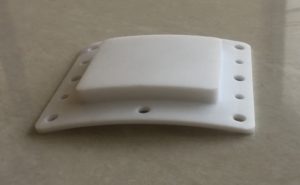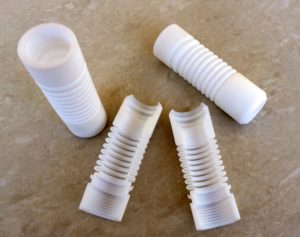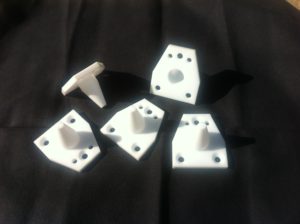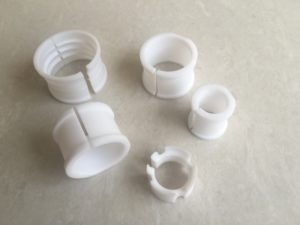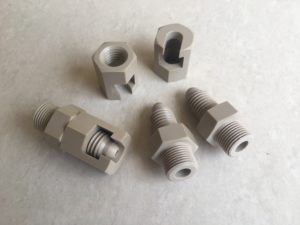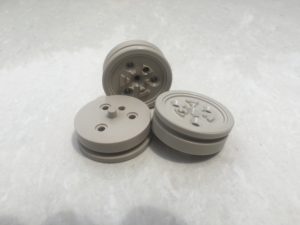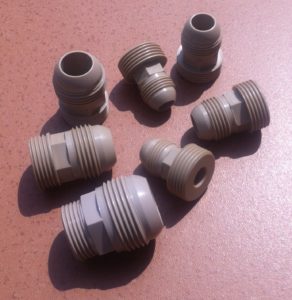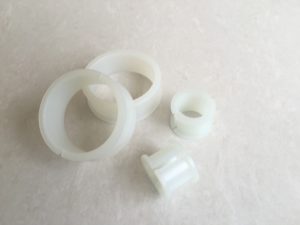As a sealing element, PTFE has proven itself many times over. PTFE is used in seals because it encompasses all the properties essential for a good sealing element, mainly:
- High wear resistance
- Low coefficient of friction
- Moderate hardness (allowing for better overall mating with metal parts)
- Durability – both with temperature as well as corrosion
While these properties are not new to us, every material has a limit to how much it can withstand. Furthermore, every grade of PTFE offers something different to the sealing application. Understanding these limits and differences gives us a better understanding into choosing and applying PTFE seals to best suit the requirement.
Sealing is vital to almost any mechanical assembly. It serves to both retain fluid within the assembly and allows the assembly to function freely. A good sealing material – such as PTFE, needs to be elastic enough to close gaps and assist with the fluid retention while strong enough to take the wear load applied on it by (usually) metal mating parts. Still, within any assembly, there is likely to be some trade off between fluid retention and durability, and this is where the choice of grade becomes important. Typically, the following metrics needs to be studied:
Surface Finish
PTFE wears off in layers, and will usually deposit a coating on the mating surface. In general, it is easy to attain a surface finish of as high as Ra < 0.4 on a virgin PTFE part. However, once we introduce other materials such as glass, carbon, graphite or bronze into the mix, there is a huge drop in the finish. We have successfully attained a finish of Ra < 1.2 on PTFE+15% Glass seals – but going below this is always a challenge.
For the mating part, the surface finish is somewhat more important – as it is usually a metal and can wear the PTFE out significantly faster if not properly finished. When the metal surface is rough, more wear occurs until the crevices and valleys within the metal are filled with PTFE. PTFE will wear in direct proportion to the surface finish. Testing shows that the life of the seal is doubled when the finish is improved from 16rms to 8rms.
Surface finish also affects the sealing ability of PTFE. A rough finish creates microscopic “line of sight” channels allowing a flow path through mating parts. Hence, when sealing gases with small molecules, such as, hydrogen, helium, or oxygen, a 2-4 rms is highly recommended.
Hardness
When the mating part is hardened (via heat treatment or plating), there is a significant improvement in the life of the seal. Typically, when a hard and soft surface are in contact, there is an exchange of ions, which can lead to adhesion. This reduces the effectiveness of the seal. Improving the surface hardness of the metal part can control the adhesion.
PV Value
PV is an often-quoted metric for all PTFE grades. It offers a trade-off between the pressure that the PTFE can take, against the speed at which the mating part is sliding against the PTFE. Understanding PV is key to understating whether the PTFE grade being considered at would be able to withstand the combination of load and RPM involved.
Disregarding PV values would almost certainly lead to a failure in the seal to perform. We have received many requests to look into the replacement of standard phosphor-bronze bushings, bearings and seals with PTFE grades. In most cases, PTFE looks to be a perfect substitute along most metrics. However, when we look at the pressure it can withstand under high RPMs, PTFE is not always suitable.
Types of seals
Given the diversity in automotive and mechanical applications, a number of different PTFE seal dimensions have been developed – each with it’s own unique property. When we cross these dimensions with the different PTFE grades, we end up with potentially hundreds of sealing options. Thus, choosing the right seal is important and a lot of thought needs to go into the same, before a decision is made.
The spring-energised seal is a sealing device consisting of a PTFE ‘energized’ by a corrosion resistant metal spring. Put simply – as PTFE is a soft material, it can be easily deformed by the metal parts surrounding it. The spring acts as a strengthening medium – allowing the PTFE to take loads while also applying force on the sealing surfaces to create a tighter fit and ensure no leakages. The spring also provides resiliency to compensate for seal wear, gland misalignment or eccentricity.
Types of such spring energized seals include:
This is mainly used in dynamic applications, has good sealing and a low coefficient of friction. It is recommended for surface speeds up to 250ft/min.
This is designed for more static or slow dynamic applications. It is not as flexible as the finger design – owing to the fact that the spring is coiled and more rigid as a result. However, it is significantly better than the finger design in sealing – due to the uniform pressure applied on all sides by the coil spring.
A more augmented version of the single coil – this is designed for purely static applications, such as cryogenics. The increased load applied by the double coil significantly improves sealing ability.
This can be used in both static and dynamic applications and offers a good balance between the seal-ability of the coil energised seal and the flexibility of the finger spring. It is typically incorporated in areas where metallic springs cannot be used due to compatibility issues.
Lip seals are used primarily to seal rotary elements such as shafts and bores. They provide a self-lubricating medium between (usually) two metal elements – allowing for both smooth rotation and good sealing. Common examples include strut seals, hydraulic pump seals, axle seals, power steering seals, and valve stem seals.
Lip seals may be designed with or without springs – depending on the application.
The examples shown above are merely indicative of the basic designs available in PTFE seals. In truth, each of the above types of seals may be expanded into many variants, depending on the exact requirements of the mating elements involved in the OEM designs. Furthermore, each may be provided in any of a number of grades of PTFE compounds available.
Choosing a PTFE compound for your PTFE seals
The grade of PTFE is a critical choice in the design of the seal. We have touched elsewhere on the variants and properties offered by the commonly used fillers in PTFE. In a nutshell – glass offers stiffness and creep resistance; bronze and molybdenum di sulphide offer wear resistance, but increase the coefficient of friction; carbon and graphite offer wear resistance and dimensional stability.
In our experience, a mixture of glass and molybdenum di sulphide offers the ideal sealing properties for most applications. However – the exact grade is usually a choice made by the OEM, based on what information we are able to provide.

